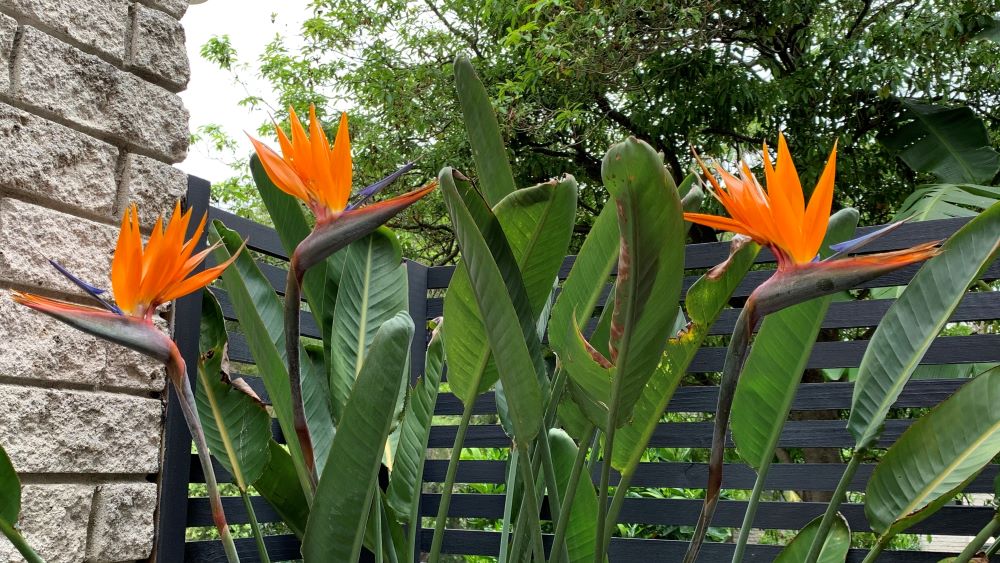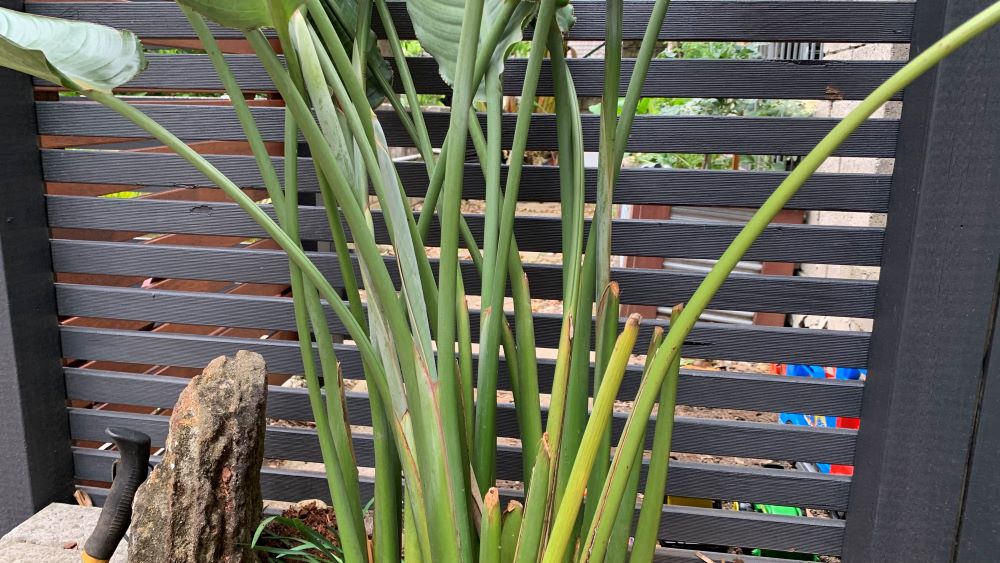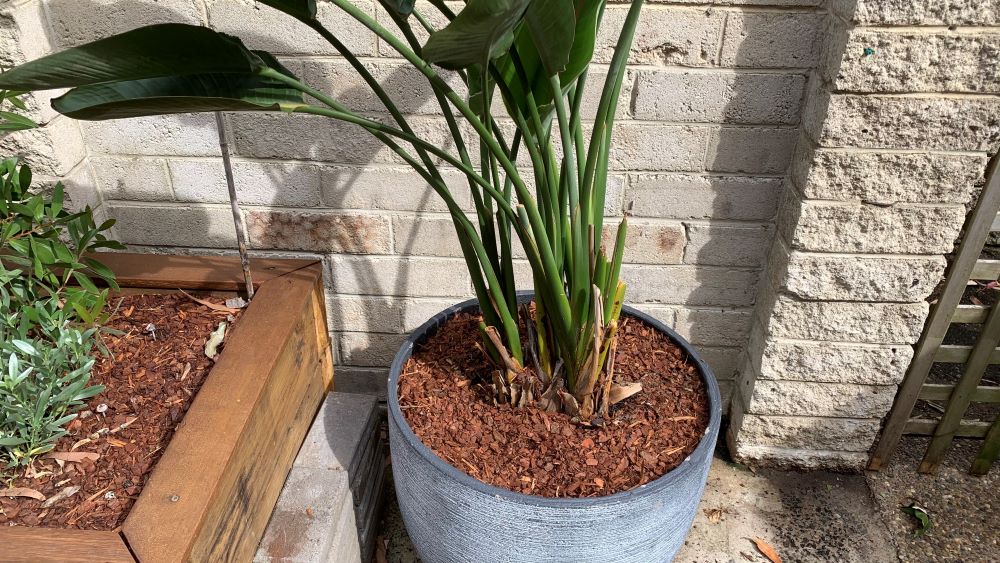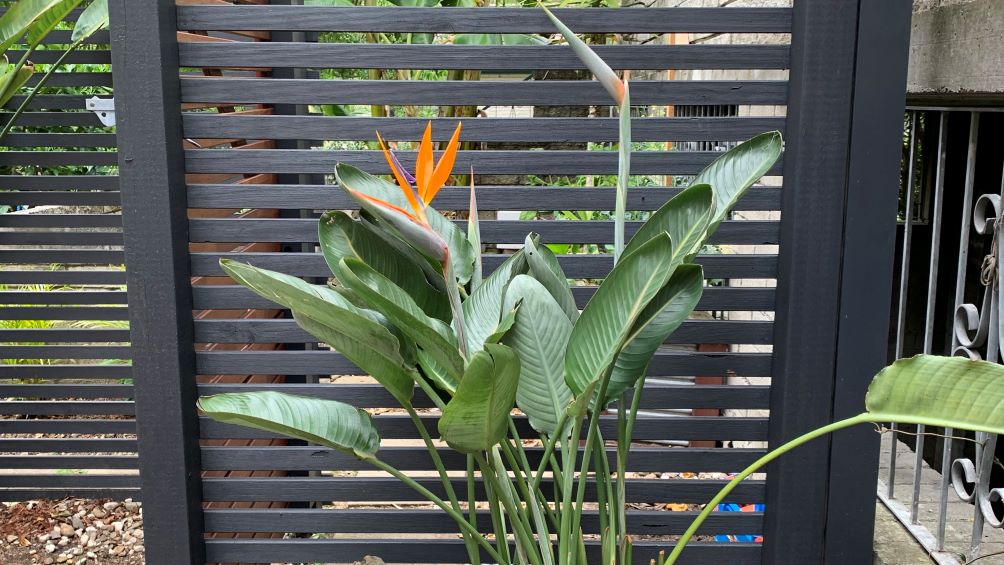A brand new bird of paradise plant will start of small and take 2-3 years to double in size and 4-5 years before its first flowers. Once a large bird of paradise plants have been split it can take another 2-3 years before it flowers again.

I recently re-potted 4 very large bird of paradise plants and they started flowering in 2 months. I transplanted them in winter because their current pots were breaking.
These plants recovered quickly growing flowers and new leaves in early Spring.
Growth rate of bird of paradise
There are 3 main species of bird of paradise that are common with Strelitzia reginae popular in tropical backyards with large, orange and blue flowers. This orange bird of paradise is common and will grow to 6 feet high in the right conditions.
There is also Strelitzia Nicolai, the giant bird of paradise that can grow up to 30 feet high and Strelitzia juncea which looks similar to Strelitzia reginae but with smaller, tighter leaves. The giant bird of paradise can grow up to 2 feet in a year in the right conditions. They can be trimmed down smaller but make a great outdoor specimen if you have the space.
Understanding Bird of Paradise Growth
If you’re planning to grow a bird of paradise plant, it’s essential to understand how fast it grows. Here are some key factors that affect the growth rate of bird of paradise:
1. Light
Bird of paradise plants require bright, indirect light to thrive. They can survive in medium light conditions, but it could slow down their growth. For maximum growth, keep the plant in a location where it will receive at least 6 hours of bright light throughout the day. For outdoor plants, a position with partial shade in the afternoon is best to protect their leaves from sunburn.
2. Watering
Over-watering or under-watering can stunt the growth of your bird of paradise plant. Give the plant regular water and water it thoroughly when the top inch of soil is dry. Keep potted plants lifted out of water by adding pot feet and making sure the pot has plenty of drainage holes.
3. Temperature
Bird of paradise plants prefer warm temperatures between 60-70°F. If the temperature drops below 50°F, it can slow down the growth rate of the plant.

4. Soil
Bird of paradise plants prefer well-draining soil that’s rich in organic matter. Use a potting mix that’s specifically formulated for tropical plants.
5. Fertilizer
Fertilize your bird of paradise plant every 2-3 months during the growing season with a balanced fertilizer. Avoid over-fertilizing, as it can burn the roots and stunt the growth of the plant. I like to use pelleted chicken manure as it is organic and also feeds soil bacteria.
6. Location
Bird of paradise plants are relatively slow-growing compared to some other houseplants. When grown indoors, they can produce 2-3 new leaves per year, with each leaf measuring between 18 and 24 inches in length. It can take up to four years for the plant to flower if grown indoors.
Bird of paradise plants in the right location outdoors will grow much quicker. They can grow several new leaves per year and loads of flowers.

How Fast Bird of Paradise Grow Outdoors
Bird of paradise plants (Strelitzia reginae) will grow new leaves in the warmer months in Spring and early Summer. These plants will take 2 years to establish and around 5 years to reach up to around 5-6 feet.
Keep the plant well-watered, plant it in good quality potting mixed or improved garden soil and they will grow large in a few years.
These plants will grow multiple stems which can be divided into new plants. Remember before you do this that the plant will take up to 3 years to recover from the move and start flowering again.
Bird of paradise plants will actually thrive in a tight fitting pot. They will grow more flowers and still have great system growth.

How Fast Bird of Paradise Grow Indoors
Bird of paradise plants will grow slower indoors than in the perfect position outdoors. If you live in a cooler climate, these plants can thrive inside near a bright window.
You can expect around 1 foot of growth per year in general for indoor bird of paradise plants but the main aim is to increase leaf and flower growth. A tight, bushy plant indoors look great. Extra leaves can be removed to keep the form tight. You can also remove very tall leaves if they are getting in the way.
Bird of Paradise Growth Timeline
The growth timeline of a bird of paradise plant can vary depending on the conditions it is grown in. Generally, it takes around 3 to 5 years for the plant to mature before it starts flowering. Here’s a breakdown of the growth timeline of a bird of paradise plant:
- Year 1: During the first year of growth, the bird of paradise plant will focus on establishing its root system and developing its leaves. It is common for the plant to produce 2-3 new leaves during this time.
- Year 2: By the second year, the bird of paradise plant should have developed a strong root system and will start producing more leaves. It is common for the plant to produce 3-4 new leaves during this time.
- Year 3: In the third year of growth, the bird of paradise plant will continue to produce new leaves and may start to produce its first flower. However, it is not uncommon for the plant to take up to 4 years to start flowering.
- Year 4 and beyond: Once the bird of paradise plant has reached maturity, it will continue to produce new leaves and flowers each year. With the right conditions, the plant can produce multiple flowers at once.
Factors such as lighting, temperature, and humidity can all impact the growth rate of a bird of paradise plant. To ensure optimal growth, make sure to provide your plant with bright, indirect light, warm temperatures, and regular watering. Additionally, fertilizing your plant every 2-3 months can help promote healthy growth and flowering.
How to Get Bird of Paradise to Grow Faster
There are some easy ways to get your bird of paradise plant to grow faster and to flower well. Here are my easy tips to encourage more growth.
1. Liquid fertilizer
A gentle feed of liquid fertilizer can give your plant an extra boost of nitrogen to encourage it to grow more leaves. Add diluted fish emulsion mixed with seaweed solution to act as a root tonic. This can be applied every 4 weeks in the warmer weather to give your plant a boost.
2. Remove dead leaves and flowers
Removing dead or dying leaves will leave more room for the light to reach the healthy leaf stems. Brown or damaged leaves can be trimmed off down to the healthy stem connection. Use sharp, clean secateurs to trim off the stem at an angle.
The extra leaves and flowers stems can be composted and will break down quicker if they are chopped into pieces.
3. Mulch the plant including pots
Mulch is the best way to keep the plant’s roots moist and healthy. While it is important not to overwater bird of paradise as the roots can rot, mulch can help to regulate the moisture loss from the soil. Bark mulch will actually absorb some of the excess water from the rain or watering.

The bark mulch will slowly release extra water back into the soil to feed the plant. The mulch will also reduce weed competition allowing the plant to grow as quickly as possible.
Bird of Paradise Growth Rate Factors
Bird of paradise plants are relatively slow-growing compared to some other houseplants. However, several factors can impact the growth rate of your bird of paradise plant. Here are some of the most crucial factors to consider:
1. Light Requirements
Birds of paradise require bright, indirect sunlight to grow properly. If your plant is not receiving enough light, it may grow more slowly or even stop growing altogether. Ideally, your bird of paradise should receive at least six hours of bright, indirect sunlight per day. If you’re growing your plant indoors, you may need to supplement with artificial light to ensure it gets enough light.
2. Soil Conditions
The soil conditions can also impact the growth rate of your bird of paradise plant. These plants prefer well-draining soil that is rich in organic matter. If the soil is too heavy or compacted, it can impede the plant’s growth. Make sure to use a high-quality potting mix that is specifically formulated for tropical plants.
3. Watering Needs
Birds of paradise require regular watering to thrive, but overwatering can be just as harmful as underwatering. The soil should be kept consistently moist but not waterlogged. Water your plant deeply once a week, allowing the soil to dry out slightly between waterings. Avoid getting water on the leaves, as this can cause them to rot.
4. Climate
Climate can also play a role in the growth rate of your bird of paradise plant. These plants prefer warm, humid environments and may struggle in dry or cold climates. If you live in an area with low humidity, you may need to increase the humidity around your plant by misting it regularly or using a humidifier.
Additionally, if you live in a cold climate, you may need to bring your plant indoors during the winter months to protect it from frost.
Promoting Optimal Bird of Paradise Growth
To ensure that your bird of paradise plant reaches its full potential, it’s important to provide it with the right care. Here are some tips to promote optimal growth:
1. Proper Pruning
Pruning is an essential part of maintaining the health and appearance of your bird of paradise plant. Regular pruning can help promote healthy growth and prevent the plant from becoming too leggy or top-heavy.
When pruning your bird of paradise, focus on removing any dead or damaged leaves and stems. You can also trim back any overgrown branches to encourage new growth. It is also best to remove dead flower heads as soon as possible. Trim them off close to the base of the stem and pop them in your compost.
2. Fertilize
Fertilizing your bird of paradise plant can help provide it with the nutrients it needs to grow and thrive. When choosing a fertilizer, look for one that is specifically formulated for tropical plants or go for a balanced organic fertilizer like pelleted chicken manure.
Fertilize your plant at the start of the growing season in spring.

3. Re-pot when it has outgrown its home
As your bird of paradise grows, it may need to be moved into a new pot. When re-potting, choose a container that is one size larger than the current one. Before re-potting, gently loosen the roots to encourage new growth. Be sure to use a well-draining potting mix to prevent water from accumulating in the soil and causing root rot.
Common Problems that Slow Bird of Paradise Growth
When it comes to growing a Bird of Paradise plant, there are a few common problems that you may face. These problems can slow down the growth of your plant, and even cause it to die if not addressed properly. In this section, we will discuss some of the most common growth problems that Bird of Paradise plants face and how to deal with them.
Pests
Bird of Paradise plants can be affected by a variety of pests, including spider mites, mealybugs, and scale insects. These pests can suck the sap out of the leaves, causing them to turn yellow and fall off. To prevent pest infestations, you should regularly inspect your plant and remove any dead leaves or debris that may attract pests. You can also use insecticidal soap or neem oil to control pest populations.
Diseases
Bird of Paradise plants are susceptible to a few different diseases, including leaf spot, root rot, and crown rot. Leaf spot is caused by a fungal infection and can be identified by brown or black spots on the leaves. Root rot and crown rot are caused by overwatering and can cause the roots to rot and the plant to wilt.
To prevent these diseases, you should avoid overwatering your plant and ensure that it has good drainage. If you notice any signs of disease, you should remove the affected leaves and treat the plant with a fungicide. Always water at the base of the plant to reduce the chances of spreading fungus and disease.
Nutrient Deficiencies
Bird of Paradise plants require a balanced diet of nutrients to grow properly. If your plant is not getting enough nutrients, it may exhibit stunted growth, yellowing leaves, or other signs of nutrient deficiencies.
To prevent nutrient deficiencies, you should fertilize your plant regularly with a balanced fertilizer. You can also use a foliar spray to provide your plant with additional nutrients. If you notice any signs of nutrient deficiencies, you should adjust your fertilization schedule accordingly.
Summary
Bird of paradise can grow up to 2 feet per year if they are cared for well. Plant in good quality potting soil, water regularly and add liquid nitrogen fertilizer in Spring. A full sun position is best for fast growth for outdoor plants and a bright window will work well for indoor plants.
Keep the soil moist by adding mulch to reduce weed competition. Bird of paradise plants are a fantastic specimen plant that looks great against a wall, screen or planted as a feature plant in a pot. These are quickly becoming one of my favorite plants and if you live in a tropical or subtropical area they will thrive without too much attention.
Frequently Asked Questions
How big should the pot be for a large bird of paradise?
Bird of paradise plants can reach as tall as 6 feet for the species with the orange flowers (Strelitzia reginae). I had recently moved a very large plant with at least 4 main plants which had grown from a single original. This plant was at least 5 years old and very heavy to move.
For this large plant, I chose a relatively small pot. This would help to keep the roots stable and tight and encourage the plant to flower quickly. The pot that I chose was around 16 inches across which was just large enough to fit this plant.
When moving and placing a large bird of paradise plant in a pot make sure it is placed on a stable base and in a position where dogs and kids won’t knock it over. I found a nice corner at the end of a garden bed near a garden screen.
This large bird of paradise, transplanted well, did not lose leaves and flowered in the next 2 months.
What is the typical growth rate of Strelitzia species?
Bird of Paradise plants are known for their moderate growth rate. Strelitzia species can grow up to 30 feet or more (for the larger species) in 5-6 years if the optimal growing conditions are met. However, it may take up to four years for the plant to flower if grown indoors. The height of an indoor Bird of Paradise typically ranges from 3 to 6 feet.
How long does it take for a Bird of Paradise to reach maturity?
Bird of Paradise plants can take several years to reach maturity. The exact time frame depends on the growing conditions and the specific species of Strelitzia. Generally, it takes around 5-6 years for the plant to reach its full height and produce blooms.
What are the optimal growing conditions for a Bird of Paradise?
Bird of Paradise plants prefer warm, humid environments with plenty of sunlight. They require well-drained soil that is consistently moist but not waterlogged. The plant can tolerate some drought, but it should not be allowed to dry out completely. Fertilizers can be used to provide additional nutrients, but it is important not to over-fertilize as this can damage the plant.
Can fertilizers or other treatments help speed up Bird of Paradise growth?
Fertilizers and other treatments can help promote healthy growth in Bird of Paradise plants. However, it is important to use them correctly and not overdo it. Too much fertilizer or other treatments can damage the plant and slow down its growth. Follow the instructions carefully and monitor the plant for any signs of stress or damage.
What should I do if my Bird of Paradise is not growing as fast as I expected?
If your Bird of Paradise is not growing as fast as you expected, there may be several factors at play. Check the growing conditions to ensure that they are optimal for the plant. Make sure the soil is well-drained and consistently moist, and that the plant is getting enough sunlight. If necessary, adjust the fertilization or other treatments to provide additional nutrients. If the problem persists, consider consulting a professional gardener or horticulturist for advice.
Are there any common problems that can slow down Bird of Paradise growth?
Bird of Paradise plants can be susceptible to a variety of pests and diseases that can slow down their growth. Common problems include fungal infections, spider mites, and mealybugs. To prevent these issues, it is important to maintain optimal growing conditions and monitor the plant regularly for any signs of stress or damage. If you notice any problems, take action immediately to prevent them from spreading and causing further damage.
I am an accredited practicing dietitian, experienced gardener and a dedicated cook. I love writing and sharing my experience so you can learn from my successes and mistakes.
